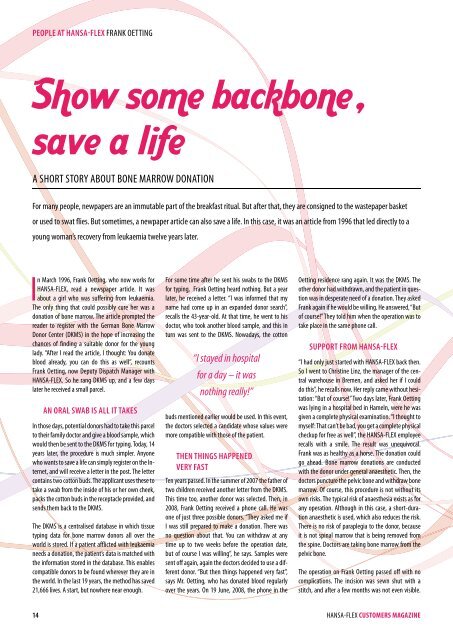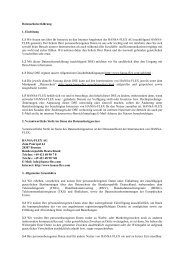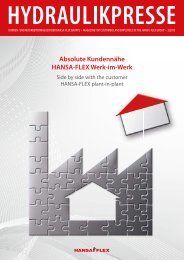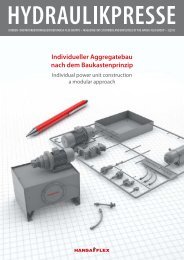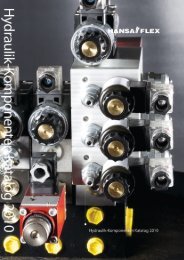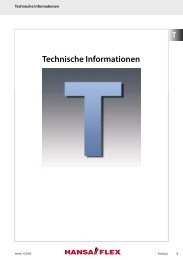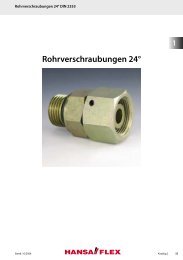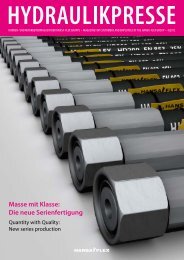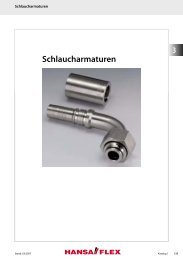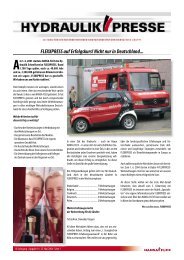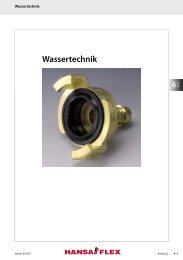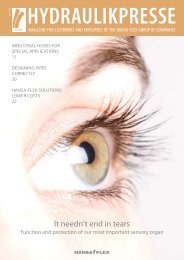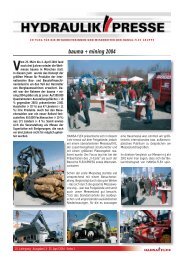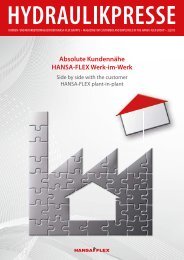HYDraUlikPresse - Hydraulic powerhouses - Hansa Flex
HYDraUlikPresse - Hydraulic powerhouses - Hansa Flex
HYDraUlikPresse - Hydraulic powerhouses - Hansa Flex
Create successful ePaper yourself
Turn your PDF publications into a flip-book with our unique Google optimized e-Paper software.
PeoPle at HaNsa-FleX FrANk oEttiNg<br />
Show some backbone ,<br />
save a life<br />
A SHort StorY About boNE mArrow doNAtioN<br />
For many people, newpapers are an immutable part of the breakfast ritual. but after that, they are consigned to the wastepaper basket<br />
or used to swat fl ies. but sometimes, a newpaper article can also save a life. in this case, it was an article from 1996 that led directly to a<br />
young woman’s recovery from leukaemia twelve years later.<br />
in march 1996, Frank oetting, who now works for<br />
HANSA-FLEX, read a newspaper article. it was<br />
about a girl who was suffering from leukaemia.<br />
the only thing that could possibly cure her was a<br />
donation of bone marrow. the article prompted the<br />
reader to register with the german bone marrow<br />
donor center (dkmS) in the hope of increasing the<br />
chances of finding a suitable donor for the young<br />
lady. “After i read the article, i thought: You donate<br />
blood already, you can do this as well”, recounts<br />
Frank oetting, now deputy dispatch manager with<br />
HANSA-FLEX. So he rang dkmS up, and a few days<br />
later he received a small parcel.<br />
aN oral sWaB is all it takes<br />
in those days, potential donors had to take this parcel<br />
to their family doctor and give a blood sample, which<br />
would then be sent to the dkmS for typing. today, 14<br />
years later, the procedure is much simpler. Anyone<br />
who wants to save a life can simply register on the internet,<br />
and will receive a letter in the post. the letter<br />
contains two cotton buds. the applicant uses these to<br />
take a swab from the inside of his or her own cheek,<br />
packs the cotton buds in the receptacle provided, and<br />
sends them back to the dkmS.<br />
the dkmS is a centralised database in which tissue<br />
typing data for bone marrow donors all over the<br />
world is stored. if a patient afflicted with leukaemia<br />
needs a donation, the patient’s data is matched with<br />
the information stored in the database. this enables<br />
compatible donors to be found wherever they are in<br />
the world. in the last 19 years, the method has saved<br />
21,666 lives. A start, but nowhere near enough.<br />
For some time after he sent his swabs to the dkmS<br />
for typing, Frank oetting heard nothing. but a year<br />
later, he received a letter. “i was informed that my<br />
name had come up in an expanded donor search”,<br />
recalls the 43-year-old. At that time, he went to his<br />
doctor, who took another blood sample, and this in<br />
turn was sent to the dkmS. Nowadays, the cotton<br />
“I stayed in hospital<br />
for a day – it was<br />
nothing really!”<br />
buds mentioned earlier would be used. in this event,<br />
the doctors selected a candidate whose values were<br />
more compatible with those of the patient.<br />
tHeN tHiNGs HaPPeNeD<br />
VerY Fast<br />
ten years passed. in the summer of 2007 the father of<br />
two children received another letter from the dkmS.<br />
this time too, another donor was selected. then, in<br />
2008, Frank oetting received a phone call. He was<br />
one of just three possible donors. “they asked me if<br />
i was still prepared to make a donation. there was<br />
no question about that. You can withdraw at any<br />
time up to two weeks before the operation date,<br />
but of course i was willing”, he says. Samples were<br />
sent off again, again the doctors decided to use a different<br />
donor. “but then things happened very fast”,<br />
says mr. oetting, who has donated blood regularly<br />
over the years. on 19 June, 2008, the phone in the<br />
oetting residence rang again. it was the dkmS. the<br />
other donor had withdrawn, and the patient in question<br />
was in desperate need of a donation. they asked<br />
Frank again if he would be willing. He answered, “but<br />
of course!” they told him when the operation was to<br />
take place in the same phone call.<br />
sUPPort FroM HaNsa-FleX<br />
“i had only just started with HANSA-FLEX back then.<br />
So i went to christine Linz, the manager of the central<br />
warehouse in bremen, and asked her if i could<br />
do this”, he recalls now. Her reply came without hesitation:<br />
“but of course!” two days later, Frank oetting<br />
was lying in a hospital bed in Hameln, were he was<br />
given a complete physical examination. “i thought to<br />
myself: that can’t be bad, you get a complete physical<br />
checkup for free as well”, the HANSA-FLEX employee<br />
recalls with a smile. the result was unequivocal.<br />
Frank was as healthy as a horse. the donation could<br />
go ahead. bone marrow donations are conducted<br />
with the donor under general anaesthetic. then, the<br />
doctors puncture the pelvic bone and withdraw bone<br />
marrow. of course, this procedure is not without its<br />
own risks. the typical risk of anaesthesia exists as for<br />
any operation. Although in this case, a short-duration<br />
anaesthetic is used, which also reduces the risk.<br />
there is no risk of paraplegia to the donor, because<br />
it is not spinal marrow that is being removed from<br />
the spine. doctors are taking bone marrow from the<br />
pelvic bone.<br />
the operation on Frank oetting passed off with no<br />
complications. the incision was sewn shut with a<br />
stitch, and after a few months was not even visible.<br />
14 HANSA-FLEX Customers magazine


